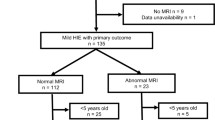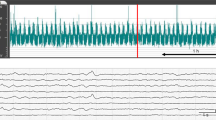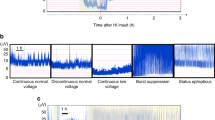Abstract
Objective:
Amplitude-integrated electroencephalography (aEEG) has been used adjunctively to identify infants suitable for hypothermic neuroprotection following severe intrapartum asphyxia. To determine whether an early aEEG predicts short-term adverse outcome in infants with significant hypoxic–ischemic encephalopathy (HIE) evaluated for hypothermic neuroprotection.
Study Design:
The aEEG recordings were obtained within 6 h of birth in infants ⩾36 weeks' gestational age during evaluation for possible selective head or whole-body cooling. Recordings were subsequently re-evaluated for both background pattern and voltage abnormalities by a certified reader masked to clinical history and brain-oriented interventions. All infants with moderate or severe HIE evaluated for hypothermic neuroprotection also underwent magnetic resonance imaging (MRI) of the brain at a median postnatal age of 7 days. The predictive value using the aEEG for determining short-term dichotomous outcomes, defined as early death related to HIE, or a characteristic pattern of abnormalities consistent with hypoxic–ischemic injury on the MRI brain scans was assessed.
Result:
Fifty-four infants with moderate or severe HIE were evaluated with aEEG for hypothermic neuroprotection; 34 infants received selective head cooling, 12 infants underwent total body cooling and 8 infants were not cooled. Outcome data, available for 46 of the 54 infants, revealed a poor correlation between the early aEEG and short-term adverse outcomes, with a sensitivity of 54.8% and negative predictive value (NPV) of only 44%.
Conclusion:
Because of the poor NPV of an early aEEG for a short-term adverse outcome, its use as an ‘additional selection criterion’ for hypothermic neuroprotection may not be appropriate.
This is a preview of subscription content, access via your institution
Access options
Subscribe to this journal
Receive 12 print issues and online access
$259.00 per year
only $21.58 per issue
Buy this article
- Purchase on Springer Link
- Instant access to full article PDF
Prices may be subject to local taxes which are calculated during checkout
Similar content being viewed by others
References
Volpe JJ . Hypoxic–ischemic encephalopathy: clinical aspects In: Volpe JJ (ed). Neurology of the Newborn. W.B. Saunders: Philadelphia, 1994, pp 314–369.
Gunn AJ, Gunn TR, Gunning MI, Williams CE, Gluckman PD . Neuroprotection with prolonged head cooling started before postischemic seizures in fetal sheep. Pediatrics 1998; 102: 1098–1106.
Gluckman PD, Wyatt JS, Azzopardi D, Ballard R, Edwards AD, Ferriero DM et al. Selective head cooling with mild systemic hypothermia after neonatal encephalopathy: multicentre randomised trial. Lancet 2005; 365: 663–670.
Rutherford M, Pennock J, Schwieso J, Cowan F, Dubowitz L . Hypoxic–ischaemic encephalopathy: early and late magnetic resonance imaging findings in relation to outcome. Arch Dis Child Fetal Neonatal Ed 1996; 75: F145–F151.
Rutherford MA, Pennock JM, Counsell SJ, Mercuri E, Cowan FM, Dubowitz LM et al. Abnormal magnetic resonance signal in the internal capsule predicts poor neurodevelopmental outcome in infants with hypoxic–ischemic encephalopathy. Pediatrics 1998; 102: 323–328.
Sarnat HB, Sarnat MS . Neonatal encephalopathy following fetal distress: a clinical and electroencephalographic study. Arch Neurol 1976; 33: 696–705.
Shankaran S, Laptook AR, Ehrenkranz RA, Tyson JE, McDonald SA, Donovan EF et al. Whole-body hypothermia for neonates with hypoxic–ischemic encephalopathy. N Engl J Med 2005; 353: 1574–1584.
de Vries LS, Hellstrom-Westas L . Role of cerebral function monitoring in the newborn. Arch Dis Child Fetal Neonatal Ed 2005; 90 (3): F201–F207.
al Naqeeb N, Edwards AD, Cowan FM, Azzopardi D . Assessment of neonatal encephalopathy by amplitude-integrated electroencephalography. Pediatrics 1999; 103: 1263–1271.
Ter Horst HJ, Sommer C, Bergman KA, Fock JM, van Weerden TW, Bos AF et al. Prognostic significance of amplitude-integrated EEG during the first 72 h after birth in severely asphyxiated neonates. Pediatr Res 2004; 55: 1026–1033.
van Rooij LG, Toet MC, Osredkar D, van Huffelen AC, Groenendaal F, de Vries LS . Recovery of amplitude integrated electroencephalographic background patterns within 24 h of perinatal asphyxia. Arch Dis Child Fetal Neonatal Ed 2005; 90 (3): F245–F251.
Toet MC, Hellström-Westas L, Groenendaal F, Eken P, de Vries LS . Amplitude integrated EEG 3 and 6 h after birth in full term neonates with hypoxic–ischaemic encephalopathy. Arch Dis Child Fetal Neonatal Ed 1999; 81: F19–F23.
Westgate JA, Gunn AJ, Gunn TR . Antecedents of neonatal encephalopathy with fetal acidaemia at term. Br J Obstet Gynaecol 1999; 106: 774–782.
Battin MR, Dezoete JA, Gunn TR, Gluckman PD, Gunn AJ . Neurodevelopmental outcome of infants treated with head cooling and mild hypothermia after perinatal asphyxia. Pediatrics 2001; 107: 480–484.
Wyatt JS, Gluckman PD, Liu PY, Azzopardi D, Ballard R, Edwards AD et al. Determinants of outcomes after head cooling for neonatal encephalopathy. Pediatrics 2007; 119 (5): 912–921.
Geddes R, Vannucci RC, Vannucci SJ . Delayed cerebral atrophy following moderate hypoxia-ischemia in the immature rat. Dev Neurosci 2001; 23: 180–185.
Shalak LF, Laptook AR, Velaphi SC, Perlman JM . Amplitude-integrated electroencephalography coupled with an early neurologic examination enhances prediction of term infants at risk for persistent encephalopathy. Pediatrics 2003; 111: 351–357.
Rutherford MA, Azzopardi D, Whitelaw A, Cowan F, Renowden S, Edwards AD et al. Mild hypothermia and the distribution of cerebral lesions in neonates with hypoxic–ischemic encephalopathy. Pediatrics 2005; 116 (4): 1001–1006.
Robertson CM, Finer NN, Grace MG . School performance of survivors of neonatal encephalopathy associated with birth asphyxia at term. J Pediatr 1989; 114: 753–760.
Miller SP, Latal B, Clark H, Clark H, Barnwell A, Glidden D et al. Clinical signs predict 30-month neurodevelopmental outcome after neonatal encephalopathy. Am J Obstet Gynecol 2004; 190: 93–99.
Shankaran S, Woldt E, Koepke T, Bedard MP, Nandayal R . Acute neonatal morbidity and long-term central nervous system sequelae of perinatal asphyxia in term infants. Early Hum Dev 1991; 25: 135–148.
Author information
Authors and Affiliations
Corresponding author
Rights and permissions
About this article
Cite this article
Sarkar, S., Barks, J. & Donn, S. Should amplitude-integrated electroencephalography be used to identify infants suitable for hypothermic neuroprotection?. J Perinatol 28, 117–122 (2008). https://doi.org/10.1038/sj.jp.7211882
Received:
Revised:
Accepted:
Published:
Issue Date:
DOI: https://doi.org/10.1038/sj.jp.7211882
Keywords
This article is cited by
-
Neuromonitoring in neonatal critical care part I: neonatal encephalopathy and neonates with possible seizures
Pediatric Research (2023)
-
EEG sharp waves are a biomarker of striatal neuronal survival after hypoxia-ischemia in preterm fetal sheep
Scientific Reports (2018)
-
Predictive value of amplitude-integrated EEG (aEEG) after rescue hypothermic neuroprotection for hypoxic ischemic encephalopathy: a meta-analysis
Journal of Perinatology (2017)
-
ERP evidence of preserved early memory function in term infants with neonatal encephalopathy following therapeutic hypothermia
Pediatric Research (2016)
-
Early clinical signs in neonates with hypoxic ischemic encephalopathy predict an abnormal amplitude-integrated electroencephalogram at age 6 hours
BMC Pediatrics (2013)



